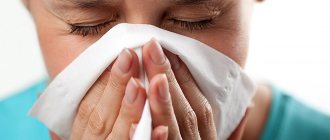Risk group
Allergy to chocolate in children
It is believed that allergy to chocolate develops only in children. This judgment is erroneous, because an allergen can cause an acute reaction in the body at any age. Therefore, an allergy to chocolate in an adult is not uncommon. This is the list of people who are most prone to hypersensitivity to their favorite sweets:
- Children. Why children? Allergies to chocolate in children are more common due to the fact that they account for a large share of chocolate products sold, and therefore the risk of allergic reactions increases. In addition, the functioning of a child’s immune system differs from that of an adult; it is much weaker.
- Aged people. Most often, in older people, the immune system is weakened, which means it is more difficult for the body to fight external irritants.
- Allergy sufferers. Hypersensitivity to the composition of other products increases the likelihood of a reaction to sweets.
- People with digestive problems. Due to the imbalance of microflora, the body perceives external influences more acutely.
Allergies or food intolerances?

Before consulting a doctor, you need to understand what the problem is: an allergy or food intolerance.
An allergy is an unreasonably violent reaction of the immune system to the appearance of foreign substances and the adoption of substances that do not pose a threat to the body, which provokes a failure of the immune system and the occurrence of allergies.
The difference between an allergy and a food intolerance is that a small piece is required for an allergic reaction to occur, but with food intolerance everything is different and the reaction occurs from an overabundance of this product in the body.
Pseudoallergy
Chocolate allergy, like any other, comes in two types: true and pseudo-allergy. Moreover, a reaction can develop not only to chocolate, but also to the products it contains: fillers, milk, nuts, in particular peanuts. Immunological mechanisms do not take part in the development of pseudoallergy. That is, there is no hypersensitivity itself, only histamine reactions are present.

Diagnosis by a doctor
Due to an increase in the level of histamine in the blood, reactions similar to allergic reactions begin. It is difficult to distinguish these species on your own. There are several points that doctors rely on when diagnosing the disease:
- Quantity. For a real allergic reaction, the amount of product consumed does not matter; it will occur even from a small piece of chocolate. To develop a pseudo-allergy, you need to eat a large amount.
- Dependence of dose on the strength of reaction. With a true allergy, the amount of allergen does not affect the strength of the allergic reaction. That is, regardless of whether you eat a piece or a bar, the reaction force will be the same. With pseudo-allergy, the more you eat, the stronger the symptoms will be.
- Heredity. With true sensitivity, heredity plays an important role. If there are allergies in the family, then the child will be more likely to suffer from hypersensitivity. Pseudo-allergy appears regardless of whether someone in the family suffers from allergies or not.
To accurately determine the type of disease, you need to consult a doctor. You can determine what type of allergic reaction you are having using a blood test.
Allergic reaction in pregnant women
The body of a pregnant woman differs in many ways from the body of a person who is not pregnant. Thanks to this difference, completely different signs, consequences and methods of treatment are added.
Expectant mothers have a rather weakened immune system and strong changes in hormonal levels, which does not go unnoticed, since the expectant mother feels allergic signs to something that did not make itself felt earlier.
Women with a history of high blood pressure and a tendency to edema are especially at risk.

Symptoms
The symptoms of a pregnant woman are no different, except that if she did not feel the reaction, this does not mean that she will not feel the characteristic signs. During pregnancy, symptoms may intensify or be the opposite of what they were before pregnancy.
Diagnostics
Food allergies are diagnosed through a blood test, which is examined for the presence of immunoglobulins E. During pregnancy, skin allergy tests are not performed due to the possible threat of harm to the fetus. This eliminates the development of pseudo-allergy.
Also an obligatory step is to study the medical history of the disease.
Note: in rare cases, examination and consultation with an obstetrician-gynecologist is required.
Complications
Complications in pregnant women are exactly the same:
- Bronchial asthma.
- Anaphylactoid reaction.
- Swelling of the larynx.
Stages of therapy
Despite these main steps, which are mandatory for any treatment, there is a complete list of steps that the doctor must carry out:
- Eliminate the allergen.
- Prescribe antihistamines.
- Reduce intoxication using sorbents.
- Normalize intestinal microflora.
- Carry out local symptomatic treatment.
- Prescribe a diet.
Prevention
If signs of irritation are detected, professional medical assistance is necessary; in no case should you take antihistamines on your own, since most of them are contraindicated for pregnant women.
The doctor, if a diagnosis is made, prescribes diet therapy for the pregnant woman and excludes allergens from the diet. Drug therapy is also prescribed. Before visiting a doctor, you should refrain from food that may be a catalyst.
Note: It is worth considering the small number of antihistamines approved for pregnant women.
It is in principle impossible to exclude the occurrence of an allergic reaction from life. It is only possible to reduce this probability to a minimum by depriving yourself of dessert, chocolate, as well as various citrus fruits, honey and products containing them.
Causes of pathology
The main components of chocolate are cocoa butter and cocoa powder. But, no matter how strange it may sound, cocoa does not cause allergic reactions. The chocolate we buy most often contains additional additives: milk, nuts, dried fruits, filling. Also, some manufacturers replace high-quality ingredients with cheaper ones. For example, instead of cocoa butter, cheap analogues are added: palm, peanut or coconut oil. And peanuts are a strong allergen that is quite capable of causing an acute reaction in a child. That is why the most non-allergenic type of chocolate is bitter. Most of its content is cocoa, so it contains fewer additives than other types of sweets.
The reaction may also occur due to the chitin contained in chocolate. Chitin is the basis of insect shells. How does it get into chocolate? It's simple: cocoa is a favorite treat of cockroaches and other insects. Manufacturing plants usually try to get rid of them, but they still find their way into the sweet stuff and are processed along with it. Allergists call chitin one of the main allergens contained in chocolate bars.
Chocolate contains lactose, which gets into it along with milk powder. Milk protein intolerance, which is more common in children, also becomes a common cause of allergic reactions.
The safest type of chocolate
The safest type of chocolate for allergy sufferers is considered to be bitter without nuts and dried fruits. It contains the maximum amount of cocoa beans and powdered sugar with no or minimal concentration of other additives.
An indicator of a quality product is the price. Cheap brands contain palm, peanut and other vegetable oils.
A high-quality product is fragile, easily breaks off, has a glossy surface, without a strong odor, and quickly melts in your hands.
Thus, the fewer components that are included in the dessert in question, the lower the risk of an allergic reaction.
In the absence of milk intolerance, milk chocolate will also be harmless. Roskoshestvo regularly conducts research on this type of dessert. Domestic ones, Rossiya, Vozdushny, Victory of Taste, Milka, Confil, Dove, Nestlé, Sobranie, are recognized as safe and comply with the technical regulations of the Customs Union.

Symptoms of a chocolate allergy

Nasal discharge is a symptom of allergies
An allergy to chocolate can have different manifestations, depending on the characteristics of a particular organism. On average, the first signs of an allergy appear 30 minutes after the allergen enters the body. However, in many cases, an allergic reaction occurs when regularly consuming large amounts of chocolate. The symptoms of a chocolate allergy are varied, but the most common ones are:
- Rashes. The skin turns red and a rash appears on it. It can develop into painful abscesses, as the patient unnoticed by himself scratches the affected areas.
- Hives. Hives are a more serious allergy symptom. Hives appear as blisters similar to nettle burns. In most cases, they are diagnosed on the arms, chest and abdomen. They disappear on their own after 12 hours, and after taking medications, within an hour.
- Dermatitis. Dry, flaky, cracked skin indicates dermatitis.
- Tearing. A sign of an allergy is uncontrollable tearing.
- Nasal discharge.
- Choking cough.
- Allergic conjunctivitis.
- Problems with the gastrointestinal tract.
- Edema.
Swelling spreads to the lips, tongue, and larynx. Swelling of the larynx is dangerous, as a person cannot breathe, which can lead to dire consequences.
In addition, acute forms of allergies include bronchial asthma and anaphylactic shock.
Medical diagnosis
Diagnosis is carried out by allergists and immunologists who specialize in the treatment of diseases of the immune system. They will decide which test to take and what to do next.
In Russia, diagnostics are carried out in private and public clinics. There are many centers in large cities. In medium and small settlements there are specialized network laboratories “Hemotest”, “Invitro”, etc.
During diagnostic procedures the following are performed:
- examination of the admitted person;
- a detailed conversation with the applicant in order to obtain information about the symptoms;
- taking blood tests;
- skin reaction tests.
To identify the substance to which the patient is allergic, a provocative examination is performed. Possible allergens are introduced into the human body in small doses.
Such studies are done in specialized clinics under the supervision of doctors. Specialists will be able to quickly relieve an adverse reaction.
If the allergen is not detected, but symptoms occur, then the patient should consult other doctors. Perhaps a direction such as psychosomatics will help.
How does an allergy to chocolate manifest itself: symptoms in children, pregnant and lactating women

Chocolate during pregnancy
Often pregnant women experience increased sensitivity due to the fact that the protective functions are weakened and the body reacts more sharply to external influences. But you shouldn’t completely exclude the product from your diet. Moderate and non-daily use is allowed. It is also not necessary that the child will be allergic to foods that the mother ate when she was pregnant. A child can become allergic only if during pregnancy the mother consumed foods to which the child may be sensitive. For example, if the father’s body reacts sharply to chocolate, and the mother ate a large amount when she was carrying the child, then the risk of sensitivity in the baby increases.
Infants suffer from increased sensitivity due to milk when an allergenic product is present in the mother's diet. How does an allergy to chocolate manifest itself in this case? An allergy to chocolate in children can manifest itself in the form of a rash and intestinal dysfunction. Most often, when a child consumes chocolate products at an older age, such a reaction is no longer observed.
How to treat an unhealthy reaction of the body
After identifying the factor (substance) causing the painful condition, an individual treatment program is selected for the patient.
First of all, contact with the allergen should be avoided. Depending on it, you will need to give up allergenic foods. Chocolate products will not be consumed in whole or in part.
It is possible that only high-quality dark chocolate will be allowed. Chocolate spread is not allowed because it contains a lot of peanuts and vegetable oils. Chocolate wrapping is also not recommended.
The doctor will prescribe medication. It can be periodic when symptoms appear or regular due to a chronic disease. The most commonly prescribed antihistamines (Zyrtec, Suprastin, Cetrin, etc.).

High-level clinics can offer biological and chemical treatments that have a positive effect on the entire immune system and stop disease processes.
In some cases, immunotherapeutic vaccinations are given.
There are also folk remedies. To relieve inflammation and irritation of the skin, infusions of chamomile, string, sage, and yarrow are used. Immunomodulators (rose hips, eleutherococcus) are taken internally. Diuretics (lingonberry, horsetail) supplemented with water are useful.
Treatment and prevention of allergies
Naturally, if any symptoms of an allergy to chocolate appear, you should immediately exclude this product from your diet. If there are signs of an allergic reaction, treatment is prescribed, which often includes:
- Cleansing the body of product residues. This can be done using absorbent substances such as activated carbon. It is worth remembering that such drugs upset the balance of intestinal microflora, so it is advisable to additionally consume fermented milk products.
- Antihistamines. Histamine produced as a defense is removed from the body. This helps clear up skin rashes. If the symptoms are more pronounced, systematic use of drugs is prescribed.
- Means of local influence. These include special creams, ointments, and nasal sprays.
- Moisturizing creams.
Treatment with folk remedies

Traditional medicine has three methods of combating allergenic reactions:
- Compresses and poultices based on sage, nettle or string.
- Add 2-3 tablespoons of pine extract and 25-30 ml of valerian root tincture to the bath.
- Crushed eggshells, diluted with a little lemon juice. Take strictly a quarter of a teaspoon per day before meals.
Note: after using sorbent drugs, the body needs to restore the intestinal microflora through drugs with lactobacilli or by consuming kefir and yogurt.
Diet
Cross foods, sweets, pickles, spicy and fatty foods are excluded from the diet. It is also recommended to rid your diet of foods that contain large amounts of acetylsalicylic acid.
- Beef;
- Exotic fruits;
- Legumes;
- Milk;
- Citrus;
- Apples;
- Peaches and apricots;
- Currant;
- Gooseberry;
- Potato.
We hope this article was helpful and you found answers to your questions.
About cross allergies
The components present in chocolate have cross-reactions with the following products.
| Chocolate component | Other products |
| Cow's milk protein | Beef, goat, mare's milk |
| Peanut | Other legumes, nuts, tomatoes, bananas, peaches, plums |
| Hazelnut | Other nuts, kiwi, sesame, poppy |
| Almond | Plum |











